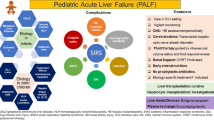Abstract
Acute liver failure (ALF) is a rare condition in the pediatric population. Patients who present with severe failure of liver synthetic function have a high mortality with medical therapy alone. The main causes of death are cerebral edema, hemorrahge, renal failure and sepsis. The etiology of ALF is age specific, with a significant number due to inborn errors of metabolism especially in neonates and infants. Treatment of children with ALF is supportive, aimed at preventing and managing associated complications until the native liver recovers or liver transplantation. Sedation should not be administered unless a decision for artificial ventilation has been made. As all children are potential transplant candidates, transfer to and management in a liver transplant centre is recommended. Prognostic criteria for mortality are less well defined compared to the adult population, although a significantly elevated INR≥4 carries a high chance of death, and liver transplantation should be considered at this stage. Auxiliary transplantation is an attractive option in selected individuals and provides the chance to stop immunosuppression should sufficient hepatic regeneration occur. The use of various liver assist devices and hepatocyte transplantation as a bridge to liver transplantation show promise, although when used in isolation, they do not have an impact on overall patient survival.
Similar content being viewed by others
References
Trey C, Davidson LS. The management of fulminant hepatic failure. In Popper H, Schaffner F, eds.Progress in Liver Disease. New York, Grune & Stratton, 1970; 3: 282–298.
O’Grady JG, Schalm SW, Williams, R. Acute liver failure: redefining the syndromes.Lancet 1993; 342: 273–275.
Bhaduri BR, Mieli-Vergani G. Fulminant hepatic failure: Pediatric Aspects.Semin Liver Dis 1996; 16: 349–355.
Tung J, Hadzic N, Layton Met al. Bone marrow failure in children with acute liver failure.J Pediatr Gastroenterol Nutr 2000; 31(5): 557–561.
Psacharopoulous HT, Mowat AP, Davies M, Portman B, Silk DBA, Williams R. Fulminant hepatic failure in childhood.Arch Dis Child 1980; 55: 252–258.
Harrison PM, Wendon JA, Gimson AES, Alexander GJM, Williams R. Improvement by acetylcysteine of hemodynamics and oxygen transport in fulminant hepatic failure.N Engl J Med 1991; 324: 1852–1857.
Singer AL, Olthoff KM, Kim H, Tand E, Samir G, Shaked A. Role of plasmapheresis in the management of acute hepatic failure in children.Ann Surg 2001; 234(3): 418–424.
Harrison P, Keays R, Bray G, Alexander G, Williams R. Improved outcome in paracetamol-induced fulminant hepatic failure following late administration of N-acety Icysteine.Lancet 1990; 335: 1572–1573.
Keays R, Harrison PM, Wendon JAet al. Intravenous N-Oacetlycysteine in paracetamol induced fulminant hepatic failure: a prospective controlleld trial.BMJ 1991; 303: 1026–1029.
Lindstedt S, Holme E, Lock EAet al. Treatment of hereditary tyrosinaemia by inhibition of 4-hydroxyphenylpyruvate dioxygenase.Lancet 1992; 340: 813–817.
Shamieh I, Kibort PK, Suchy FJ, Freese DK. Antioxidant therapy for neonatal iron storage disease.Pediatr Res 1993; 33: 109A.
Rela M, Heaton ND, Vougas Vet al. Orthotopic liver transplantation for hepatic complications of Wilson’s disease.Br J Surg 1993; 80: 909–911.
O’Grady JG, Alexander GJ, Hayllar KM, Williams R. Early indicators of progonosis in fulminant hepatic failure.Gastroenterology 1989; 97: 439–445.
Pauwels A, Mostefa-Kara N, Florent C, Levy VG. Emergency liver transplantation for acute liver failure: Evaluation of London and Clichy criteria.J Hepatol 1993; 17: 124–127.
Devictor D, Desplanques L, Debray Det al. Emergency liver transplantation for fulminant liver failure in infants and children.Hepatology 1992; 16: 1156–1162.
Tan KC, Mondragon RS, Vougas Vet al. Liver transplantation for fulminant hepatic failure and late-onset hepatic failure in children.Br J Surg 1992; 79: 1192–1194.
Dhawan A, Muiesan P, Baker AJet al. Auxiliary liver transplantation for acute hepatic failure in children.Arch Dis Child 200; 82 (Suppl 1); A3.
Bilir BM, Guinette D, Karrer Fet al. Hepatocyte transplantation in acute liver failure.Liver Transpl 2000; 6(1): 32–40.
Strom SC, Fisher RA, Thompson MTet al. Hepatocyte transplantation as a bridge to orthotopic liver transplantation in terminal liver failure.Transplantation 1997; 63(4): 559–569.
Author information
Authors and Affiliations
Rights and permissions
About this article
Cite this article
Aw, M.M., Dhawan, A. Acute liver failure. Indian J Pediatr 69, 87–91 (2002). https://doi.org/10.1007/BF02723784
Issue Date:
DOI: https://doi.org/10.1007/BF02723784




